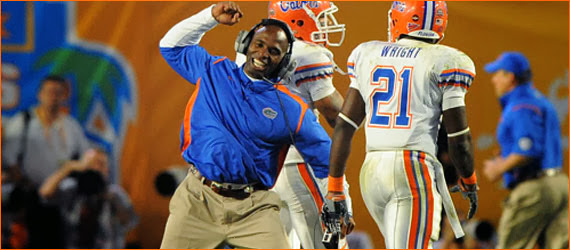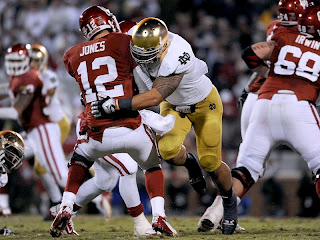Maryland leaving the ACC and Rutgers leaving the Big East (both teams are heading to the Big Ten) signals to the rest of college football that super conferences are on their way whether we like it or not (and I do not like it for the record). And when you consider the Big Ten/Pac-12 partnership for the Rose Bowl and the SEC/Big XII newly formed partnership for the so-called “Champions Bowl” (better name clearly still pending), the ACC is in deep trouble.
Just this past September, things looked very rosy for the ACC. Notre Dame agreed to join the ACC in all sports except for football but also committed to playing a minimum of five football games against ACC opponents annually. Furthermore, the ACC as a group voted to raise the overall exit fee to $50 million, although both Maryland and Florida State voted against this measure. It seemed as though Commissioner John Swofford had done enough to insulate his conference from any further defections.
But yesterday, Maryland decided it was time for them to move to greener pastures even in the face of a $50 million buyout (Maryland stands to make approximately $24 million annually compared to the $15 million it currently makes in the ACC). And although I’m certain that the ACC will quickly replace Maryland with either UConn or Louisville within the next coming weeks I am still making the following declaration:

The ACC will cease to exist as a preeminent BCS football conference in the next coming years.
The high stakes game of Conference Realignment (which I’m calling Collegiate Football Risk) comes down to one thing: Acquiring more television markets to generate more Benjamins, and participating in a preeminent BCS bowl.
Although the ACC currently has teams in and around nine of the top 20 U.S. TV markets (New York, Chicago, Philadelphia, Boston, Atlanta, Washington D.C., Tampa, Miami, Orlando), I believe that their lack of a preeminent/important BCS bowl tie (Orange Bowl***) in will be their final undoing even with the impending playoff format.
***Please note that in my opinion, the Orange Bowl doesn’t really count as an important college football bowl in the grand scheme of it all. It’s located in Miami and far too corporate. And outside of the national championship game in Miami, it has the lowest Nielsen ratings year over year of all the other BCS Bowls (see post #1 for more details about Nielsen’s).
The two biggest power brokers in conference realignment thus far have been the Big Ten and the SEC. With 14 teams already, both conferences are best positioned to become the first 16-team super conference. As a result, in the post ACC (and Big East) world of college football they will work together to create the first two true 16-team Super Conferences.
I predict that the SEC will look as follows (please note that in the parenthesis is ranking of the relating larger TV market served by related team):
 West
West Texas A&M -Houston (10)
Missouri -St. Louis (21)
LSU -New Orleans/Shreveport (53/84)
Arkansas -Little Rock (56)
Alabama -Birmingham/Mobile (40/60)
Auburn -Birmingham/Mobile (40/60)
Mississippi State -Jackson (90)
Ole Miss -Jackson (90)
East
Georgia -Atlanta (8)
Va. Tech -Washington D.C. (9)
Florida -Tampa/Jacksonville (13/47)
NC State -Raleigh-Durham (27)
Vanderbilt -Nashville (29)
South Carolina -Greenville/Columbia (36/79)
Kentucky -Memphis (48)
Tennessee -Knoxville (59)
I predict that the Big Ten will look as follows (please note that in the parenthesis is ranking of the relating larger TV market served by related team):
Legends
Illinois -Chicago (3)
Iowa -Des Moines-Ames (71)
Michigan -Detroit (11)
Michigan State -Detroit (11)
Minnesota -MSP (15)
Nebraska -Omaha (76)
Northwestern -Chicago (3)
Wisconsin -Madison (85)
Leaders
Indiana -Indianapolis (25)
Ohio State -Cleveland/Columbus (18/32)
Penn State -Philadelphia/Pitt (4/23)
Purdue -Indianapolis (25)
Boston College -Boston (7)
Rutgers -New York (1)
Maryland -Washington DC (9)
UNC -Raleigh-Durham (27)
Current legislation in the state of North Carolina forces UNC to be in the same conference as NC State unless NC State can find a home in another BCS conference. In other words, UNC can only split from NC State if NC State ends up in another BCS conference. As a result, The SEC and the Big Ten will make a deal to split the Charlotte (24) and the Raleigh-Durham (27) television markets by taking NC State and UNC respectively.
The Big Ten will then move to lock up the Boston television market (even though Boston isn’t necessarily a huge college football market) by taking Boston College. The SEC will round out the overall television market package with Virginia Tech which will give them the Washington D.C. (9), Richmond (58) and Roanoke-Lynchburg (67) television markets
At 16 apiece and a majority of the major U.S. television markets consumed, the Big Ten and the SEC will stop (I hope to God!) leaving the Pac-12 and the Big 12 to fight over the remaining remnants of the ACC and Big East.
The Big 12 currently has 10 members and would need to attract 6 new teams to reach Super Conference status. Current members and their related TV markets are as follows:

Texas -Dallas-Ft. Worth/Austin (5/49)
Oklahoma -Dallas-Ft. Worth/O.K.C. (5/45)
Texas Tech -Dallas-Ft. Worth (5)
TCU -Dallas-Ft. Worth (5)
Oklahoma State -O.C.K. (45)
Baylor -San Antonio (37)
Iowa State -Des Moines-Ames (71)
Kansas -Kansas City (31)
Kansas State -Kansas City (31)
West Virginia – ……… It’s West Virginia
Upon further analysis, you start to see a very consistent theme with the current Big 12 …. It’s very Texas focused. And while I love me some Texas, it’s simply not enough to survive the new cut throat world of conference realignment. As a result they will have to be aggressive in the expansion of their television footprint.
At the same time you have the Pac-12, currently sitting pretty with 12 members but also suffering from the same geographical concentration as the Big 12.
Because both the Big 12 and Pac-12 will be eager to expand (not certain if all the way to 16), the remaining “attractive” teams in the ACC (Miami, Florida State, Clemson, Georgia Tech, Duke, Wake Forest, Virginia, Pittsburgh, and Syracuse) and Big East teams (Connecticut, Cincinnati, South Florida, Louisville) will have the power in deciding where they end up (grade-A suppliers market).
Due to the geographical constraints of the Pac-12 (all remaining teams are approximately 1,500 to 2,000 miles away from the closet Pac-12 school) and the simple fact that there are only four really good television markets remaining, I believe the Big 12 will go to 14 (Miami, Florida State, Clemson, Georgia Tech) bringing them the Miami-Ft. Lauderdale (16), Tampa (13), Jacksonville (47), Greenville (36) and Atlanta (8) television markets.
At 12-teams and their partnership with the Big Ten, the Pac-12 is safe even though they are the smallest conference in terms of numbers but they will definitely have the smallest television contract in the future world of the post Conference Realignment game of Risk.
In closing, I just want to say that as a fan of college football, I am utterly disgusted at the sheer lack of respect for college football traditions. This high stakes game of realignment is driven solely by greed and money. At the same time, I’d be a liar if I told you that if I were the commissioner of a major conference I wouldn’t be doing the same thing for the sake of the overall conference.
So fans of college football, enjoy the last couple years of tradition. In the post conference realignment world, tradition will be all but dead.
P.S. I didn’t talk much about Notre Dame primarily because this year’s performance all but solidifies the fact that they will never join a conference.
































